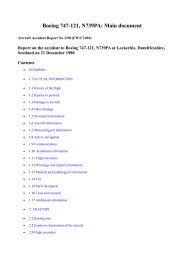REPORT OF THE - Archives - Syracuse University
REPORT OF THE - Archives - Syracuse University
REPORT OF THE - Archives - Syracuse University
You also want an ePaper? Increase the reach of your titles
YUMPU automatically turns print PDFs into web optimized ePapers that Google loves.
Since the extraordinary measures were tightened following Pan Am 103, U.S. carriers<br />
must match every bag to a passenger who has boarded the aircraft. At highest threat<br />
airports, all baggage must also be X-rayed or searched by hand. The purpose of matching,<br />
or "reconciling", baggage is to assure that a terrorist does not check a suitcase containing<br />
a bomb and then simply walk away from the airport, leaving the bomb to take innocent<br />
lives.<br />
Once screened and in the hands of the airline, the bag must be accessible only to<br />
authorized personnel, and under surveillance at all times. If it is placed in a container, the<br />
container must be closed securely.<br />
In addition to greater scrutiny of passengers and baggage, the extraordinary security<br />
procedures prescribed by FAA call for controlled access to the aircraft by servicing<br />
personnel, searches of the aircraft cabin and holds between flights, and modest controls<br />
over cargo. In reality, the FAA oversees security controls only for checked or carry-on<br />
items screened by the carrier. Third parties, whose security programs lie outside of the<br />
FAA jurisdiction, control security procedures for other items. Cargo and mail pose<br />
particular problems, which are addressed in a subsequent section.<br />
Foreign Air Carriers<br />
The Federal Aviation Act gives FAA jurisdiction over foreign carriers on the last leg of<br />
their flight to the United States. In May 1989, the FAA embarked on a new program<br />
requiring foreign air carriers to adopt certain measures for each point of operation within<br />
the United States and for the last point of departure to the United States. As of December<br />
1989, 135 foreign air carriers were subject to this requirement.<br />
FAA has accepted 52 programs, most of which were the model programs offered to the<br />
carriers by the FAA. However, 39 carriers from 20 countries also exercised the option to<br />
refer FAA to the foreign government responsible for security at the last point of departure<br />
into the United States. This has both complicated and increased the FAA's workload. In<br />
these cases, FAA must work through the State Department to deal with each of the<br />
foreign governments rather than the carriers.<br />
The passenger and baggage screening requirements imposed by FAA on foreign air<br />
carriers at overseas locations are not as stringent as those required of U.S. carriers there.<br />
FAA does not have the authority under existing international agreements to impose<br />
requirements on foreign carriers in foreign countries that exceed the standards and<br />
recommended practices of ICAO. For example, while both U.S. and foreign carriers<br />
perform a positive match of passengers and checked baggage, the U.S. carriers must X-<br />
ray or physically search all baggage as well, whereas the foreign carriers have to X-ray or<br />
physically search only that baggage for which no passenger has boarded the airplane. As<br />
will be discussed later, this less stringent requirement for foreign carriers raises concerns<br />
for the security of U.S. passengers who fly foreign airlines.<br />
Foreign Approaches to Security<br />
To gain an understanding of aviation security abroad, the Commission visited three<br />
European Countries: the Federal Republic of Germany, France, and the United Kingdom.<br />
The U.K. and West Germany were selected because of their connection with Pan Am<br />
Flight 103 and France because of the more recent UTA Flight 772 bombing. Among<br />
those killed on the UTA flight were seven Americans, including the wife of the U.S.<br />
Ambassador to Chad.










